Indoor plants have become an integral part of modern Indian homes, offices, and public spaces. They not only enhance the aesthetic appeal of interiors but also contribute to improving air quality, reducing stress, and bringing nature closer. With India’s diverse climate and urbanization, indoor gardening has gained immense popularity. This article highlights the top 10 most common indoor house plants in India, their characteristics, care requirements, and benefits.
1. Areca Palm (Dypsis lutescens)
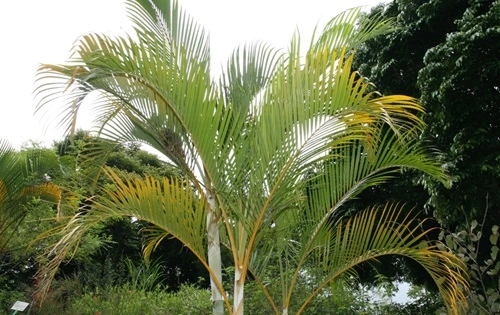
The Areca Palm is one of the most popular indoor plants in India, known for its elegant, feathery fronds and ability to purify air. It thrives in low-light conditions, making it ideal for homes and offices.
Key Features:
- Height: Up to 6-7 feet indoors
- Light: Indirect sunlight
- Watering: Keep the soil moist but avoid overwatering.
Benefits:
- Improves air quality by filtering toxins.
- Adds a tropical touch to interiors.
- Low maintenance and pet-friendly.
2. Money Plant (Epipremnum aureum)
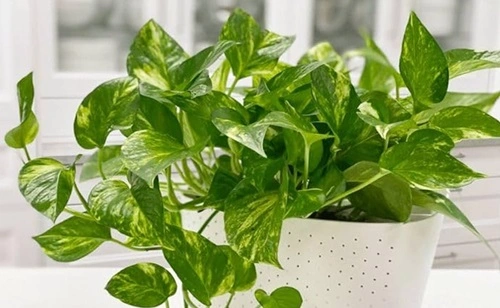
The Money Plant is a staple in Indian households, believed to bring prosperity and good luck. Its trailing vines make it a versatile choice for indoor décor.
Key Features:
- Growth: Fast-growing climber or creeper
- Light: Thrives in indirect light but tolerates low light
- Watering: Water when the soil feels dry.
Benefits:
- Known for its air-purifying properties.
- Easy to grow and propagate.
- Versatile use in hanging baskets, pots, or water jars.
3. Snake Plant (Sansevieria trifasciata)
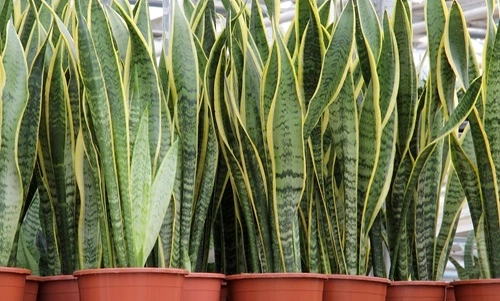
The Snake Plant, also known as Mother-in-Law’s Tongue, is famous for its striking upright leaves and resilience. It’s perfect for beginners or those with a busy lifestyle.
Key Features:
- Height: 6 inches to 3 feet
- Light: Tolerates low to bright indirect light
- Watering: Water sparingly; drought-tolerant.
Benefits:
- Filters indoor air, including toxins like formaldehyde.
- Releases oxygen at night, making it ideal for bedrooms.
- Extremely low maintenance and hardy.
4. Peace Lily (Spathiphyllum spp.)
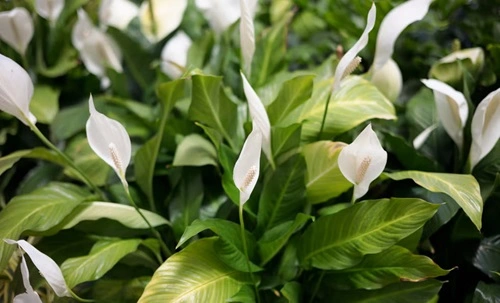
The Peace Lily is a stunning plant with glossy leaves and elegant white blooms, often associated with peace and serenity. It’s an excellent choice for low-light areas.
Key Features:
- Height: 1-3 feet
- Light: Prefers low to medium indirect light
- Watering: Water when the soil dries out slightly.
Benefits:
- Acts as a natural air purifier.
- Adds a touch of elegance with its flowers.
- Easy to care for and maintain.
5. Aloe Vera (Aloe barbadensis miller)
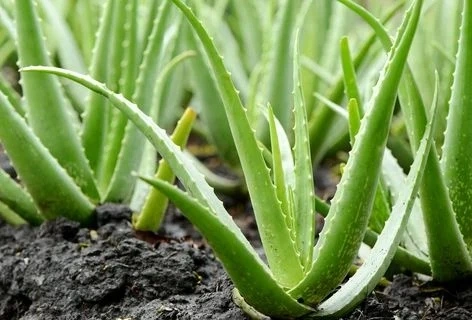
Aloe Vera is a multipurpose plant valued for its medicinal properties and low maintenance. It’s a popular choice for both indoor and outdoor gardening.
Key Features:
- Height: 1-2 feet
- Light: Bright indirect sunlight
- Watering: Allow the soil to dry out completely before watering.
Benefits:
- Gel from its leaves is used for skincare and first-aid remedies.
- Improves air quality by removing toxins.
- Requires minimal care and is drought-tolerant.
6. Spider Plant (Chlorophytum comosum)
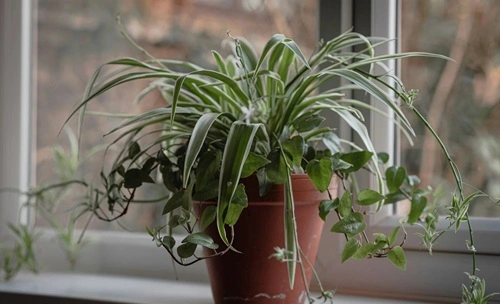
The Spider Plant is a versatile and hardy plant with arching leaves that create a cascading effect. Its adaptability makes it a common indoor plant in India.
Key Features:
- Height: 1-2 feet
- Light: Bright, indirect sunlight
- Watering: Water when the topsoil dries out.
Benefits:
- Effective in removing airborne toxins like carbon monoxide.
- Non-toxic and safe for pets.
- Adds aesthetic appeal to hanging baskets and shelves.
7. Rubber Plant (Ficus elastica)
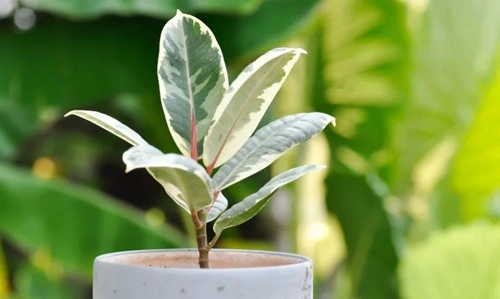
The Rubber Plant is a popular indoor choice, known for its large, glossy leaves and low-maintenance requirements. It’s an excellent statement plant for living rooms.
Key Features:
- Height: Up to 8 feet indoors
- Light: Prefers bright, indirect light
- Watering: Water when the top inch of soil feels dry.
Benefits:
- Improves indoor air quality.
- Adds a lush, tropical vibe to interiors.
- Low-maintenance and long-lasting.
8. Boston Fern (Nephrolepis exaltata)
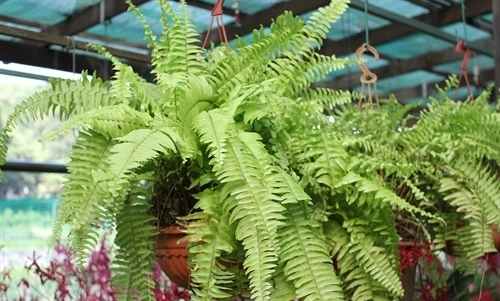
Boston Ferns are known for their lush, arching fronds that bring a touch of greenery and elegance to indoor spaces.
Key Features:
- Height: 1-3 feet
- Light: Indirect light; avoid direct sunlight
- Watering: Keep the soil consistently moist.
Benefits:
- Enhances air quality by removing pollutants.
- Adds texture and volume to indoor plant arrangements.
- Creates a natural, calming atmosphere.
9. Philodendron (Philodendron spp.)
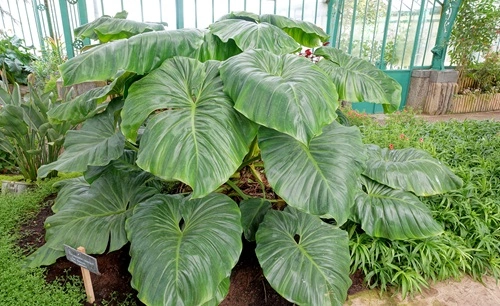
Philodendrons are a diverse group of plants, ranging from trailing vines to upright species. Their adaptability and unique leaf shapes make them a favorite in Indian homes.
Key Features:
- Height: Varies from small climbers to large bushy plants
- Light: Indirect sunlight; tolerates low light
- Watering: Allow the topsoil to dry out between waterings.
Benefits:
- Known for its air-purifying properties.
- Low-maintenance and easy to propagate.
- Versatile for hanging baskets, tabletops, or floor pots.
10. Pothos (Epipremnum aureum)
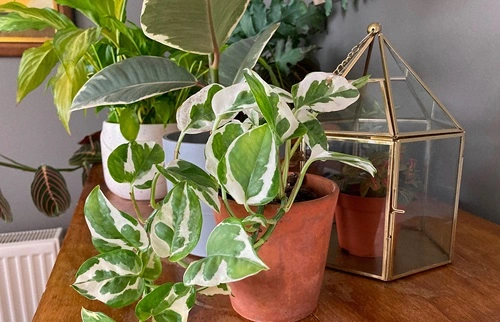
Often confused with the Money Plant, Pothos is a low-maintenance plant with heart-shaped leaves. Its trailing vines make it an excellent choice for shelves or hanging pots.
Key Features:
- Growth: Vigorous climber
- Light: Thrives in low to bright indirect light
- Watering: Water when the soil feels dry.
Benefits:
- Improves indoor air quality by filtering toxins.
- Perfect for beginners due to its hardiness.
- Adds greenery to small spaces like kitchens and bathrooms.
Why Indoor Plants Are Popular in India
- Air Purification: Many indoor plants remove toxins like formaldehyde, benzene, and carbon monoxide, improving indoor air quality.
- Stress Reduction: The presence of greenery is proven to lower stress and enhance mood.
- Aesthetic Appeal: Indoor plants complement modern interiors, adding a natural and refreshing touch.
- Low Maintenance: Most indoor plants require minimal care, making them ideal for urban lifestyles.
Tips for Caring for Indoor Plants
- Light: Place plants where they can receive the appropriate amount of light as per their needs.
- Watering: Avoid overwatering; ensure proper drainage to prevent root rot.
- Soil: Use well-draining potting soil suitable for indoor plants.
- Humidity: Mist plants or place a water tray nearby to maintain humidity, especially in air-conditioned spaces.
- Pruning: Remove dead or yellowing leaves to promote healthy growth.
Conclusion
Indoor plants not only beautify living spaces but also bring numerous health and environmental benefits. From the resilient Snake Plant to the elegant Peace Lily, the top 10 common indoor plants in India cater to diverse preferences and care levels. By incorporating these green companions into your home, you can create a tranquil, healthier, and more vibrant environment. With a little care and attention, indoor gardening can become a fulfilling and rewarding experience for anyone.

